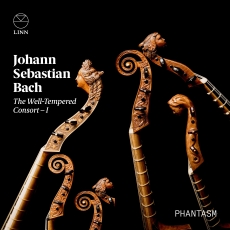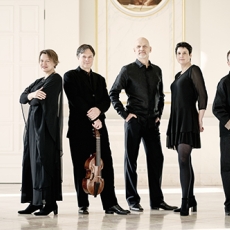Phantasm - J.S. Bach: The Well-Tempered Consort – I - Rondo (FI)
Johann Sebastian Bach ei säveltänyt musiikkia gambayhtyeelle, mutta gambaconsortien edustama moniääninen ihanne oli hänelle tuttu. Moniäänisyys ei ollut Bachille vain pitkästä perinteestä polveutunut historiallinen ilmiö. Polyfonialla hän sai soimaan erilaiset ja ristiriitaisetkin inhimilliset pyrinnöt, ja siitä kasvoi yhteys maailman harmoniaan, johon barokkiestetiikassa vielä uskottiin. Bach tutki moniäänisyyttä urku- ja cembaloteoksissaan ja esimerkiksi pianisti ja tutkija Charles Rosenin mukaan ainoastaan kosketinsoittaja pystyy demonstroimaan täysipainoisesti fuugien moniäänistä liikettä, äänien sekoittumista, eroamista ja vuorovaikutusta. Phantasm-yhtyeen vetäjä Laurence Dreyfus näkee kuitenkin, että gamba-yhtye on sekä historiansa että luonteensa puolesta oiva väline Bachin moniäänisen musiikin esittämiseen. Gambaconsortissa jokainen soittaja vastaa omasta äänestään, mutta vuorovaikutuksellaan myös kokonaisuudesta.
Ajatus ”hyvävireisestä” consortista – viitteenä Bachin Das Wohltemperiertes Clavieriin – ei siis ole tuulesta temmattu. Phantasm on poiminut valikoimaansa näytteitä, jotka istuvat tällaisiin sovituksiin hyvin. Ja todettakoon jälleen kerran, ettei Bach mitenkään paheksunut teostensa esittämistä eri soittimilla ja kokoonpanoilla.
Phantasmin katsauksen alussa ja lopussa kuullaan Bachin Musiikillisen uhrilahjan Ricercare, ensimmäisenä kolmiääninen ja viimeisenä kuusiääninen. Matkan varrella kuullaan näytteitä mm. Das Wohltemperiertes Clavierista (I-II), inventioista ja Clavierübungista. Pelkistä teknisistä taidonnäytteistä ei ole kyse, vaan musiikista kumpuaa myös väkevää henkisyyttä, ilmeisinä esimerkkeinä urkukoraalit An Wasserflüssen Babylons ja Vater unser im Himmelreich (”Isä meidän, joka olet taivaassa”).
Joissakin tapauksissa kappaleita on sovitettu gamboille sopivammaksi, toisissa taas on lähdetty kokeilemaan rohkeasti sävellajeja soittimien mukavuusalueen ulkopuolelta. Bachin stylus fantasticus ja moniäänisten fantasioiden perinne kohtaavat levyllä jännittävällä tavalla, jossa urku- ja cembaloteosten yksilöllisestä ilmaisusta kasvaa consort-musiikin yhteistä ajatusten ja äänien virtaa.
Gambayhtyeen mattapintainen sointi tuo musiikkiin intiimiä patinaa ja Phantasm on polyfonisen äänenkuljetuksen mestari. Kaikki on huolella jäsennelty ja eritelty, mutta soi sulavasti yhteen. Ehkä Dreyfusin diskanttigamba voisi välillä soida sulokkaamminkin, mutta yhtye on edelleen lajinsa huipulla, kivijalkanaan bassogambaa soittava Markku Luolajan-Mikkola. Levyotsikon järjestysnumero lupailee erinomaiselle äänitteelle jatkoa.
Although Johann Sebastian Bach didn’t compose music for the viol consort, the polyphonic ideal embodied by a consort of viols was familiar to him. For Bach, polyphony wasn’t just an historical practice stemming from a long tradition. Within polyphony, he was able to craft a way to echo diverse and contradictory human aspirations, and this project itself was linked to the harmony of the spheres, a common belief within Baroque aesthetics.
Bach made a point of mastering polyphony in his organ and harpsichord works, and according to pianist and writer Charles Rosen, for example, only a keyboardist can fully control the polyphonic flux, as in the mixing, separation, and interaction between fugal voices. Yet as Laurence Dreyfus, leader of Phantasm notes, the viol consort, both in terms of its history and character, is an ideal tool for realising Bach's polyphony, for not only is each player in a viol consort is responsible for their own voice, but also for the interaction as a whole. The idea of a “well-tempered” consort - a reference to Bach’s Well-Tempered Clavier – is therefore not some idea plucked out of thin air, and Phantasm has selected pieces that function well as polyphonic arrangements.
Bach himself was in no way against the performance of his works on various instruments and ensembles. At the beginning and end of the Phantasm’s survey we hear ricercars from Bach’s Musical Offering, first for three and at the end for six voices. And along the way, examples are selected from the two books of the Well-Tempered Clavier, the Inventions and the Clavierübung. Not only are these technically superb masterpieces, but there is also a strong spirituality emanating from this music, as, for example, in the organ chorale An Wasserflüssen Babylons.
In some cases, keys have been adapted to be more suitable for the viols, while in other cases, the players embark on bold experiments that taken them outside the comfort range of their instruments. Bach’s stylus phantasticus and the tradition of polyphonic fantasies converge on this recording in an exciting way, such that the approach in a consort heightens the individual expression as usually heard on organ and harpsichord.
The sutble sound quality of the consort endows the music with an intimate patina, and Phantasm is a master of conveying the flow of the polyphonic sonorities. Everything is carefully structured and articulated, yet remains smooth and coordinated. While Dreyfus’s treble viol might sometimes speak even more sweetly, this consort is still at the top of its game, with Markku Luolajan-Mikkola playing of the bass viol on a rock-solid footing. The sequence number given in the disc title promises a sequel to this excellent recording.

